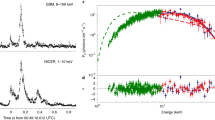Abstract
The emission lines reported at 400–500 keV in the spectra of γ-ray bursts1 have been interpreted as redshifted positron annihilation lines, and, together with the lower-energy cyclotron lines1, are the most direct evidence that bursts occur on the surface of neutron stars2. Therefore, it is important to confirm the existence and determine the properties of these features. So far, the most significant detections of emission features have been reported from the Konus experiments on Veneras 11–14. Possible confirmatory observations have suffered from limited statistical significance or difficulties in interpretation. Here we compare measurements of a γ-ray burst at 01:37 UT on 31 December 1981, using the Solar Maximum Mission (SMM) γ-ray spectrometer with those made by the Konus instruments. The SMM spectra exhibit no evidence for the presence of emission features reported by the Konus group3.
This is a preview of subscription content, access via your institution
Access options
Subscribe to this journal
Receive 51 print issues and online access
$199.00 per year
only $3.90 per issue
Buy this article
- Purchase on Springer Link
- Instant access to full article PDF
Prices may be subject to local taxes which are calculated during checkout
Similar content being viewed by others
References
Mazets, E. P., Golenetskii, S. V., Aptekar, R. L., Guryan, Yu. A. & Il'inskii, V. N. Nature 290, 378–382 (1981).
Mazets, E. P., Golenetskii, S. V., Il'inskii, V. N., Aptekar, R. L. & Guryan, Yu. A. Nature 282, 587–589 (1979).
Mazets, E. P. et al. Positron–Electron Pairs in Astrophysics (eds Burns, M. L., Harding, A. K. & Ramaty, R.) 36–53 (AIP, New York, 1983).
Cline, T. L. et al. Astrophys. J. Lett. 237, L1–L5 (1980).
Barat, C. Positron–Electron Pairs in Astrophysics. (eds Burns, M. L., Harding, A. K. & Ramaty, R.) 54–58 (AIP, New York, 1983).
Teegarden, B. J. & Cline, T. L. Astrophys. J. Lett. 236, L67–L70 (1980).
Fenimore, E. E., Klebesadel, R. W., Laros, J. G., Stockdale, R. E. & Kane, S. R. Nature 297, 665–667 (1982).
Forrest, D. J. et al. Sol. Phys. 65, 15–23 (1980).
Forrest, D. J. Position–Electron Pairs in Astrophysics (eds Burns, M. L., Harding, A. K. & Ramaty, R.) 3–14 (AIP, New York, 1983).
Share, G. H. et al. in Positron–Electron Pairs in Astrophysics (eds Burns, M. L., Harding, A. K. & Ramaty, R.) 15–20 (AIP, New York, 1983).
Nolan, P. L. et al. Positron–Electron Pairs in Astrophysics (eds Burns, M. L., Harding, A. K. & Ramaty, R.) 59–63 (AIP, New York, 1983).
Author information
Authors and Affiliations
Rights and permissions
About this article
Cite this article
Nolan, P., Share, G., Chupp, E. et al. Spectral feature of 31 December 1981 γ-ray burst not confirmed. Nature 311, 360–362 (1984). https://doi.org/10.1038/311360a0
Received:
Accepted:
Issue Date:
DOI: https://doi.org/10.1038/311360a0
This article is cited by
-
Annihilation radiation in cosmic gamma-ray bursts
Astrophysics and Space Science (1986)
Comments
By submitting a comment you agree to abide by our Terms and Community Guidelines. If you find something abusive or that does not comply with our terms or guidelines please flag it as inappropriate.



